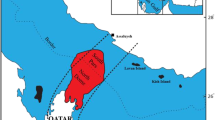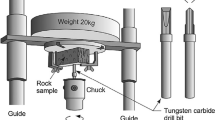Abstract
As regards to deficiency or lack of core data and high cost of coring, it was seen necessary to utilize drilling data to study and compare calculated dynamic parameters by log, instead of core data. The elastic modulus of rock includes E (Young’s modulus), ν (Poisson’s ratio), K (bulk modulus), and G (shear modulus) which are essential geomechanical parameters which are widely used for analysis wellbore stability. In this study, due to the unavailability of the core data, the weight on bit (WOB) was used to compare the rock strength parameters instead of core data. These parameters were calculated by a DSI (dipole shear sonic imager) tool, RHOB, and NPHI log for the Dalan Formation. As regards, the amount of rock porosity is a direct relationship with rock density, and both parameters are effective on wellbore stability and ROP, the relationship between porosity and rock strength parameters was studied. As regards, the amount of rock strength is effective on ROP and WOB, and according to the availability of WOB data, the calculated parameters were compared with WOB. The results indicated that the value of these parameters has an inverse relationship with the amount of porosity. By investigating the relationship between porosity and elastic modulus, it was found that the elastic modulus decreases with increasing porosity. The comparison of porosity and elastic modules denoted that among elastic modulus, bulk modulus has the highest correlation with porosity, and the Poisson ratio has the least correlation with porosity. The UCS (unconfined compressive stress) calculated with the static Young’s modulus showed the best correlation with porosity than the calculated UCS. An essential part of the drilling process is adding force to the drill bit in order to successfully break the rock. Weight on bit is the amount of downward force exerted on the drill bit. The amount of WOB is depending on the rock strength, which is the minimum stress required to fail the rock formation. Comparison of calculating the elastic modulus and UCS with weight on bit illustrated that the calculated UCS with Es has the best correlation with weight on bit. By comparing the calculated elastic modulus with the weight on bit (WOB), it was found that these parameters are in a good matching with the parameter obtained through drilling and so it can be applied to assess the accuracy of the calculated elastic modulus parameters.







Similar content being viewed by others
References
Abdlmutalib A, Abdullatif O, Korvin G, Abdulraheem A (2015) The relationship between lithological and geomechanical properties of tight carbonate rocks from Upper Jubaila and Arab-D Member outcrop analog, Central Saudi Arabia. Arab J Geosci 8(12):11031–11048. https://doi.org/10.1007/s12517-015-1957-6
Afsari M, Amani M, Razmgir SAM, Karimi H, Yousefi S (2010) Using drilling and logging data for developing 1d mechanical earth model for a mature oil field to predict and mitigate wellbore stability challenges. International Oil and Gas Conference and Exhibition in China. Soc Petrol Eng. https://doi.org/10.2118/132187-MS
Ameen M, Smart B, Somerville J, Hammilton S, Naji N (2009) Predicting rock mechanical properties of carbonates from wireline logs (a case study: Arab-D reservoir, Ghawar field, Saudi Arabia). Mar Pet Geol 26(4):430–444. https://doi.org/10.1016/j.marpetgeo.2009.01.017
Andrews RJ, Hareland G, Nygaard R, Engler TW, Virginillo BK (2007) Methods of using logs to quantify drillability. Paper presented at the Rocky Mountain Oil & Gas Technology Symposium
Asquith GB, Gibosn CR (1982) Basic well log analysis for geologists
Castagna JP, Batzle ML, Eastwood RL (1985) Relationships between compressional-wave and shear-wave velocities in clastic silicate rocks. Geophysics 50(4):571–581. https://doi.org/10.1190/1.1441933
Chang C, Zoback MD, Khaksar A (2006) Empirical relations between rock strength and physical properties in sedimentary rocks. J Pet Sci Eng 51(3):223–237. https://doi.org/10.1016/j.petrol.2006.01.003
Edgell H (1977) The Permian system as an oil and gas reservoir in Iran, Iraq and Arabia. Proc. Second Iranian Geological Symposium, Tehran
Eissa E, Kazi A (1988) Relation between static and dynamic Young’s moduli of rocks. International Journal of Rock Mechanics and Mining Sciences & Geomechanics Abstracts, Elsevier
Elkatatny S (2019) Development of a new rate of penetration model using self-adaptive differential evolution-artificial neural network. Arab J Geosci 12(2):19. https://doi.org/10.1007/s12517-018-4185-z
Farquhar R, Somerville J, Smart B (1994) Porosity as a geomechanical indicator: an application of core and log data and rock mechanics. European Petroleum Conference. London, United Kingdom, Society of Petroleum Engineers. 9. https://doi.org/10.2118/28853-MS.
Fjær E, Holt RM (1994) Rock acoustics and rock mechanics: their link in petroleum engineering. Lead Edge 13(4):255–258. https://doi.org/10.1190/1.1437017
Fjar E, Holt RM, Raaen A, Risnes R, Horsrud P (2008) Petroleum related rock mechanics. Elsevier, Hungary
Goodman RE (1989) Introduction to rock mechanics, vol 2. Wiley, New York
Hareland G, Nygaard R (2007) Calculating unconfined rock strength from drilling data. Paper presented at the 1st Canada-US Rock Mechanics Symposium
Heerden W (1987) General relations between static and dynamic moduli of rocks. Paper presented at the International Journal of Rock Mechanics and Mining Sciences & Geomechanics Abstracts
Karaman K, Kesimal A (2015) Evaluation of the influence of porosity on the engineering properties of volcanic rocks from the Eastern Black Sea Region: NE Turkey. Arab J Geosci 8(1):557–564. https://doi.org/10.1007/s12517-013-1217-6
Kazi A, Sen Z, Sadagah B-EH (1983) Relationship between sonic pulse velocity and uniaxial compressive strength of rocks. Paper presented at the The 24th US Symposium on Rock Mechanics (USRMS)
Lacy LL (1997) Dynamic rock mechanics testing for optimized fracture designs. SPE annual technical conference and exhibition, Society of Petroleum Engineers. https://doi.org/10.2118/38716-MS
Lashkaripour GR (2002) Predicting mechanical properties of mudrock from index parameters. Bull Eng Geol Environ 61(1):73–77. https://doi.org/10.1007/s100640100116
MacBeth C (2004) A classification for the pressure-sensitivity properties of a sandstone rock frame. Geophysics 69(2):497–510. https://doi.org/10.1190/1.1707070
Minaeian B, Ahangari K (2013) Estimation of uniaxial compressive strength based on P-wave and Schmidt hammer rebound using statistical method. Arab J Geosci 6(6):1925–1931. https://doi.org/10.1007/s12517-011-0460-y
Nabaei M, Shahbazi K (2012) A new approach for predrilling the unconfined rock compressive strength prediction. Pet Sci Technol 30(4):350–359. https://doi.org/10.1080/10916461003752546
Nabaei M, Shahbazi KH, Shadravan A, Amani M (2010) Uncertainty analysis in unconfined rock compressive strength prediction. SPE Deep Gas Conference and Exhibition, Society of Petroleum Engineers. https://doi.org/10.2118/131719-MS
Najibi AR, Ghafoori M, Lashkaripour GR (2015) Empirical relations between strength and static and dynamic elastic properties of Asmari and Sarvak limestones, two main oil reservoirs in Iran. J Pet Sci Eng 126:78–82. https://doi.org/10.1016/j.petrol.2014.12.010
Nauroy J-F (2011) Geomechanics applied to the petroleum industry, Editions Technip
Ohen HA (2003) Calibrated wireline mechanical rock properties model for predicting and preventing wellbore collapse and sanding. SPE European Formation Damage Conference, Society of Petroleum Engineers. https://doi.org/10.2118/82236-MS.
Onyia E (1988) Relationships between formation strength, drilling strength, and electric log properties. Paper presented at the SPE Annual Technical Conference and Exhibition
Rahimpour Bonab H, Enayati-Bidgoli AH, Navidtalab A, Mehrabi H (2014) Appraisal of intra reservoir barriers in the Permo-Triassic successions of the Central Persian Gulf, Offshore Iran. Geol Acta: Int Earth Sci J 12(1):87–107. https://doi.org/10.1344/105.000002076
Rahimpour-Bonab H (2007) A procedure for appraisal of a hydrocarbon reservoir continuity and quantification of its heterogeneity. J Pet Sci Eng 58(1):1–12. https://doi.org/10.1016/j.petrol.2006.11.004
Schei G, Fjær E, Detournay E, Kenter C, Fuh G, Zausa F (2000) The scratch test: an attractive technique for determining strength and elastic properties of sedimentary rocks. Paper presented at the SPE Annual Technical Conference and Exhibition. https://doi.org/10.2118/63255-MS
Schlumberger (1995) DSI*Dipole Shear Sonic Imager. 41
Sun F, Yao Y, Li G, Dong M (2019a) Transport behaviors of real gas mixture through nanopores of shale reservoir. J Pet Sci Eng 177:1134–1141. https://doi.org/10.1016/j.petrol.2018.12.058
Sun F, Yao Y, Li G, Li X (2019b) A slip-flow model for multi-component shale gas transport in organic nanopores. Arab J Geosci 12(5):143. https://doi.org/10.1007/s12517-019-4303-6
Sun F, Yao Y, Li G, Li X (2019c) Transport zones of oil confined in lipophilic nanopores: a technical note. Arab J Geosci 12(4):136. https://doi.org/10.1007/s12517-019-4321-4
Sun F, Yao Y, Li G, Liu W (2019d) Simulation of real gas mixture transport through aqueous nanopores during the depressurization process considering stress sensitivity. J Pet Sci Eng 178:829–837. https://doi.org/10.1016/j.petrol.2019.02.084
Sun F, Yao Y, Li G, Zhang S, Xu Z, Shi Y, Li X (2019e) A slip-flow model for oil transport in organic nanopores. J Pet Sci Eng 172:139–148. https://doi.org/10.1016/j.petrol.2018.09.045
Walker B, Black A, Klauber W, Little T, Khodaverdian M (1986) Roller-bit penetration rate response as a function of rock properties and well depth. In: Paper presented at the SPE Annual Technical Conference and Exhibition. Society of Petroleum Engineers, New Orleans, Louisiana, p 12. https://doi.org/10.2118/15620-MS.
Wang Z (2000) Dynamic versus static elastic properties of reservoir rocks. Seismic and Acoustic Velocities in Reservoir Rocks. Society of Exploration Geophysicists 3:531–539
Wyllie MRJ, Gregory AR, Gardner LW (1956) Elastic wave velocities in heterogeneous and porous media. Geophysics 21(1):41–70. https://doi.org/10.1190/1.1438217
Wyllie M, Gregory A, Gardner G (1958) An experimental investigation of factors affecting elastic wave velocities in porous media. Geophysics 23(3):459–493. https://doi.org/10.1190/1.1438493
Zhang JJ, Bentley LR (2005) Factors determining Poisson’s ratio. CREWES Res Rep 17:1–15
Zhang X, Zhai Y, Xue C, Jiang T (2011) A study of the distribution of formation drillability. Pet Sci Technol 29(2):149–159
Zoback MD (2007) Reservoir geomechanics. Cambridge University Press
Acknowledgments
The authors would like to extend their thanks to the National Iranian Drilling Company (NIDC) for providing the required data.
Author information
Authors and Affiliations
Corresponding author
Additional information
Responsible Editor: Zeynal Abiddin Erguler
Rights and permissions
About this article
Cite this article
Khoshnevis-zadeh, R., Soleimani, B. & Larki, E. Using drilling data to compare geomechanical parameters with porosity (a case study, South Pars gas field, south of Iran). Arab J Geosci 12, 611 (2019). https://doi.org/10.1007/s12517-019-4809-y
Received:
Accepted:
Published:
DOI: https://doi.org/10.1007/s12517-019-4809-y




